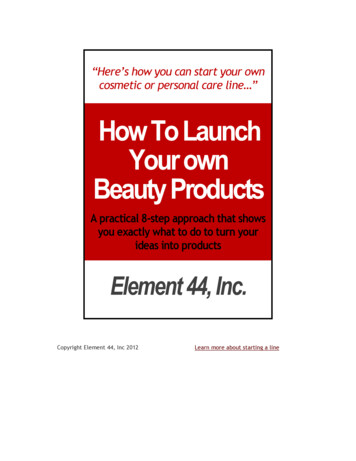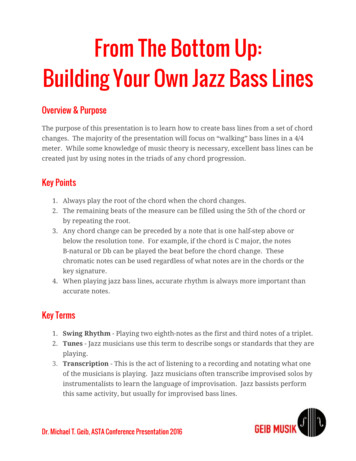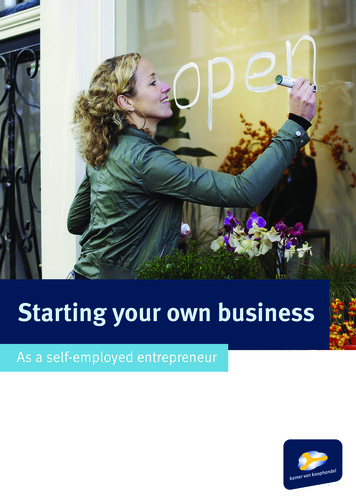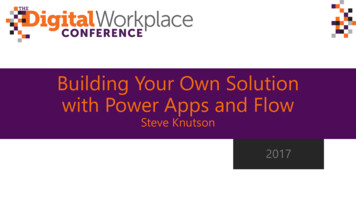
Transcription
“Here’s how you can start your owncosmetic or personal care line ”How To LaunchYour ownBeauty ProductsA practical 8-step approach that showsyou exactly what to do to turn yourideas into productsElement 44, Inc.Copyright Element 44, Inc 2012Learn more about starting a line
IntroductionSo You Want to start your own cosmetic brand?If you work in the cosmetic industry or even just use cosmetics andpersonal care products frequently, you'll begin to develop ideas about whatkind of products you think the world needs. Unfortunately, if you are likemost people, you are not in the position at your company to get your ideasmoved forward. In fact, the only way to assure that a formula or productgets made the way you want it is to create the product yourself.In this guide we outline the 8 vital steps you must follow to create a newbeauty or personal care product or line. It is our sincere hope that you willuse this information, take action and actually launch your first product. Ifyou've ever had an idea for a product but didn't know what to do next, thisreport will help you.Let's get started.Copyright Element 44, Inc 2012Learn more about starting a line
Table Of Contents“Here’s how you can start your own cosmetic or personal careline ” . 1Introduction. 2Table Of Contents. 3The 8 basic steps . 4Chapter 1: Starting a Business . 5Chapter 2: Creating a Brand . 10Chapter 3: Defining your target consumer . 15Chapter 4 - Writing your business model . 18Chapter 5 - Product development phase. 24Chapter 6 - The production phase. 33Chapter 7 - Marketing. 39Chapter 8 - Selling . 43Final Thoughts. 47Copyright Element 44, Inc 2012Learn more about starting a line
The 8 basic stepsAs you may have discovered, coming up with an idea for a new beautyproduct line is relatively easy. Since you are reading this report, you probablyhave your own already. And you have no doubt also discovered how difficult it isto go from the idea stage to the finished product stage.If you are having a problem turning your idea into an actual product, thenthis report is what you need. In it, we go through the 8 key steps you have tofollow to launch your first product. In short, the 8 basics steps include1.2.3.4.5.6.7.8.Starting a companyDeveloping a brandDefining your customerWriting your business modelCreating your productProducing your productMarketing your productSelling your productIf you follow the steps inside, you WILL be able to get past the idea stageand hold your finished product in your hand. But to actually get to this point,you must take action! This report will tell you exactly how you can launch yourown product line but we can't do it for you. The steps are easy but it will takework and an investment by you. This is not a get-rich-quick scheme. It gives youa practical guide to turning your idea into a salable product.Please read through the report with an open mind, take actions, and turn yourproduct dreams into reality.Copyright Element 44, Inc 2012Learn more about starting a line
Chapter 1: Starting a BusinessIntroductionIf you have decided you want to create your own personal care or cosmeticbrand, then you have also decided to start your own business. Starting your ownbusiness can be an incredibly rewarding endeavor. While all great things in liferequire a lot of hard work, you know that with your own business, your hard workgoes to benefit you, not another company. Entrepreneurship gives many peoplearound the world financial independence, schedule flexibility, and a lastinglegacy.In this section, we will briefly discuss the different types of businesses thatcan be formed, financing, and hiring specialized professionals such as attorneysand accountants. Please note, the following section is meant to serve as a brieftutorial of the topics and should not be misconstrued as financial or legal advice.For final decisions you should always consult a professional in that area.Sole ProprietorshipThe most basic type of business is called a sole proprietorship. This is a typeof business entity that is owned and operated by one individual. In this case,there is no legal distinction between the individual and the business. This meansthe individual owns all assets, collects all profits, and is personally responsiblefor all debts and liabilities. This differs greatly from a corporation, which we willdiscuss in the next session.Sole Proprietorships are relatively inexpensive to start and easy todiscontinue. Since they are owned and operated by one person, they can bemuch more nimble than corporations. The person can also use a registered brandname or trade mark to represent the business, instead of using their personalname. This is known as a DBA (“doing business as”), and can be filed at yourlocal municipality.Copyright Element 44, Inc 2012Learn more about starting a line
PartnershipA partnership is very similar to a sole proprietorship, except that two ormore individuals make up the business. As is the case with sole proprietors, theindividuals are personally responsible for all debts and liabilities. A partnershipagreement is also necessary in this case, so that ownership percentages, rolesand responsibilities, and the division of profits and losses can be defined.Partners can also be classified as general partners or limited partners. Generalpartners are involved with the day to day operations and share the personalliability of the company whereas limited partners typically contribute capital (soas to partake in company profits) but do not participate in day to day activities orshare in the legal risk, liabilities, and debts. Limited partners are sometimescolloquially referred to as “silent partners”.IncorporationIncorporating a business is the act of creating a separate legal entity havingits own privileges and liabilities separate from those of its members within thelaws of a state. Corporations can be made up of either public or privateshareholders - individuals who legally own shares of stock of the company, butnot the corporation itself. These shareholders have the right to vote on directorsnominated by the board (a centralized management body) and other key businessdecisions, and have the right to dividends if they are declared. Corporations thatdo not have shareholders are called non-stock corporations. Instead they havemembers who have the right to vote on its operations.A corporation has several advantages over sole proprietorships andpartnerships. The first and most obvious advantage of a corporation is that oflimited liability. Limited liability is the principle that a shareholders loss due to acorporation’s debts and obligations cannot exceed the amount in which theycontributed through payment for shares. This differs greatly in regards to soleproprietorships and partnerships, where a person’s personal assets could besought after to settle debts. Like liabilities, assets are also assigned to thecorporation, not its shareholders. This is advantageous in that it allows for theaccumulation of capital, since they are not tied to the lifetime of itsshareholders.Copyright Element 44, Inc 2012Learn more about starting a line
However, there are some disadvantages that corporations have as comparedto sole proprietorships and partnerships. Corporations typically have higher costsbecause of overhead, legal fees, and taxes. They are typically much moredifficult to dissolve and risk sluggish management because of inherentbureaucracy.Limited Liability Company (LLC)LLCs are a kind of hybrid type of business that combines characteristics ofboth sole proprietorships/partnerships and corporations. It uses the limitedliability principle from corporations but also allows for a pass through taxationoption. The income from an LLC can either be declared on its individualmember’s personal tax return or treated like a corporation by filing as a C or Scorporation. Because of this flexibility, LLCs are a great option for individuals orpartnerships who want to start a company.FinancingLet’s face it, starting a company takes money, and starting your own brandis no different. Getting financing for your endeavor will be a key factor indetermining whether your dream can get off the ground. The route in which youtake to acquire financing will greatly depend on the type of business you start, aswe discussed above.Sole Proprietorships often have to use their own savings to fund the start oftheir business. Or, they can put their personal assets up as collateral for a loan.In this sense, sole proprietors have the advantage over corporations since mostnew corporations don’t have any assets to use as collateral. Partnerships havethese same options, but also have the option of taking in private investors aslimited partners. Of course, corporations have the advantage when attractinginvestors since they can sell stock in the company, which brings with it lower riskand more regulatory protection.Whether you try to get lending or attract investors, both will require apresentation of your business plan. This will be discussed in more detail in laterCopyright Element 44, Inc 2012Learn more about starting a line
sections, but be prepared to sell your idea numerous times before finally gettingthe capital you will need.Hiring specialized professionalsAll start-ups will be limited by the expertise of its members. It is crucial toget trusted business advice from individuals with the education and experienceyou may not have. Such examples include, but are not limited to, attorneys,accountants, financial planners, chemists, packaging engineers, chemicalengineers, manufacturing, advertising, public relations, and sales professionals.It is important to find these professionals for your business so that you have theability to retain them throughout the lifespan of your company.Searching and selecting these specialized professionals will vary dependingon the type individual you are seeking. In all cases, you should interview at least3 people or firms. Before this interview, you must have a good sense of whatyour business needs are so you can mutually decide if you are a good fit for oneanother. You should also ask the professional for their background,representative examples of their work, and check out some references. Inquiringabout their service fees is an obviously important step, but don’t let it be thedeciding factor. As with most things in life, you typically get what you pay for.Remember, the reputation of your company is as stake - it doesn’t always pay tobe cheap.SummaryThe first step to starting your own cosmetic or personal care line is to set upyour business. There are a few different options including Sole Proprietorship,Partnership, LLC, and S Corporation. Which one you choose will depend on theamount of up-front investment you want to make and how much liability you arecomfortable with.Recommended Reading*StartupNation : America's Leading Entrepreneurial Experts Reveal the Secrets toBuilding a Blockbuster BusinessCopyright Element 44, Inc 2012Learn more about starting a line
*Small Time OperatorCopyright Element 44, Inc 2012Learn more about starting a line
Chapter 2: Creating a BrandIntroductionIn the last section we reviewed what it takes to start a company. Whilestarting a company is an important first step; relatively speaking, it is a simplething to do. Really, anyone can do it once they have decided on the type and arewilling to pay the registration and legal fees.In this section we are going to discuss quite another topic - creating a brand.Creating a brand is not nearly as straightforward as starting a company. Brandstake on a personality and represent something bigger, emotionally, than theproduct or service they represent. There are many brands that you interact within your daily life, Coke, Apple, McDonalds, etc. However, only a select few areimpactful enough for you to remember and identify with.We will discuss a few key elements in the process of creating a brand. Wewill review what it means to create a brand personality. We will also look atother brands as examples to digest why they are so impactful. We will also spendsome time on your brand’s point of differentiation and discuss the legal topics ofbrand trademarks and registrations.Defining your brand personalityAs we set up in the introduction, a brand is the personality of your company.It is what you use to represent what you stand for and to allow your consumers toidentify with you. Your brand should elicit a higher emotion when the generalpublic sees it.It is very important to put a lot of thought into this before launching yourproduct line. The truly impactful brands that we see are successful because theyare very clear about what they stand for, all the while being very consistent withtheir communication. It is very difficult to get a second chance at a firstimpression and the same is true for a brand. If you don’t know what you are andwhat you stand for, why would someone else want to make your brand a part oftheir life?Copyright Element 44, Inc 2012Learn more about starting a line
Your brand name, logo, and slogan are important visual elements that makeup your brand personality. Many choose to just focus on these executionalelements when creating a brand. We encourage you to think deeper than this.Think about any and all types of communication your brand will have. The sumof these in addition to your name and logo is what truly makes up your brandpersonality. Think about how these communications will look and feel. Thinkabout the attitude you want to portray. Think about the higher order values thatyou want to be associated with.It may also be useful to look to other iconic brands to analyze what makesthem successful. We encourage you to look outside your category for this type ofinspiration (technology, automotive, food, clothing, etc.). The following are afew questions that you can ask yourself to help bring the subconscious feelingsyou have to conscious thought that you can make use of: What do you think about the name? The best names stand the test oftime, can have double meanings or deeper emotional connections to theproduct or service, and typically are very easily remembered. What does the logo look like? Is it simple or complex? What kind of fontdoes it use and why do you think it was chosen. What are the role ofcolors and shapes? The best logos can be recognized even without aname. What values do you think the brand stands for? How does this relate tothe product or service? What executional elements of this brand’s communication do you admire?Is it the language they use? Or the imagery? What kind of attitude dothey portray? Do they inspire you to do or be something greater? Most importantly, how did you become a part of this brand? Said anotherway, what was it that made you invest your money in its product orservice? What is it that makes you proud to be associated with theownership of the product or the use of the service?Copyright Element 44, Inc 2012Learn more about starting a line
If you still don’t think you have your brand aptly defined, not to worry. Inour next section, we'll talk about point of differentiation can also help you focusyour thoughts.Point of differentiationImagine there is a brand with a great name, logo, and excellent definition ofpersonality and attitude. Now imagine there was another brand whosepersonality was not as strong, but was still able to offer the exact same productor service. Do you think the first brand can still be successful? Chances are theywill enjoy a moderate amount of success, but the truly great brands also have avery clear point of differentiation.A point of differentiation is a reason to believe or a reason to buy (RTB).Said another way, this is what truly makes you unique in the marketplace. It iswhat you have that no one else does. There are many big companies out therethat struggle with this point. They have a well recognized brand name but theycan’t truly define what makes them different from their competitors.A point of differentiation is especially important for a new brand entering amarket with a great amount of competition from other companies bigger thanitself. It is the David vs. Goliath mentality. However, many of the greatestbrands in the world started as the David only to beat the Goliaths because theyhad a very clear and distinct point of differentiation.So think to yourself, what makes you different? Why are your productssuperior to your competitive set? There are many ways to approach this. Themost often used is a differentiating technology. Many companies invest heavily inresearch and development so that they can provide a new benefit or a currentmarket benefit in a completely new way. Perhaps your product eliminates somesort of trade off, or has the ability to combine or simplify your consumer’s life.Again, there are many ways to become different, the important thing is that youare different and there is a compelling reason why.Copyright Element 44, Inc 2012Learn more about starting a line
Trademarks and registrationA final important aspect that we want to cover in this section is the use oftrademarks and registrations. There is a clear difference between the two andmany times are used incorrectly. The first thing to note is that trademarks are afundamental part of corporate law. They exist to make the marketplace moreefficient. If a consumer can recognize a brand they have used before, they aresure they are able to buy the same thing again. This provides a benefit to themarket, so the law provides for certain intellectual property protections on thesetypes of business tools.A trademark can be a name of a product or service, a logo, a slogan,packaging, or even sounds and smells. Essentially, a trademark can be anythingthat can help identify a particular product or service in the marketplace. The symbol is typically used for a product and is usually placed to the right of thename/logo/slogan, etc. A service mark symbol (SM) is also available for aservice, but is much less often used.The symbol can be used at anytime, assuming no one else has alreadyclaimed the rights to the mark or something very similar (something that could beeasily confused in the marketplace). Essentially, you are claiming the rights tothe mark at the first point in time you chose to use it. It is important todocument the date in which you first used the mark in case there is anothercompany who wants to use it. The company that can prove they were the first touse the mark typically obtains the rights in a legal dispute. The symbol canalso be used if the trademark has a pending registration application. The symbol is used for trademarks that are federally registered through the UnitesStates Patent and Trade Mark Office (USPTO), and should only be used once theregistration is received.SummaryThe second step to starting your own cosmetic or personal care line is tocreate your brand. The brand should be a reflection of the business and have adefined personality and most importantly, a point of differentiation. You need tostand out among a crowded field.Copyright Element 44, Inc 2012Learn more about starting a line
Recommended Reading*The Purple Cow – Seth GodinCopyright Element 44, Inc 2012Learn more about starting a line
Chapter 3: Defining your target consumerIntroductionIn the previous sections, we discussed the idea of starting a business andcreating a brand. In this section, we have decided to focus on defining yourtarget consumer. You may ask yourself why we have devoted a whole section tothis; you want to sell my product to as many people as possible. We will discussthat defining your target consumer does not mean excluding people; rather itmeans that it will focus your limited resources so that your investments have abetter return. One way small businesses can effectively compete with muchlarger competitors is their ability to target a niche market. We will also discussthe elements of target consumer definition.Benefits of definitionAs we touched upon in the introduction, defining your target consumer doesnot mean exclusion. In no way are we trying to say that certain types of peoplecan buy your product and other people cannot. The simple fact is that youcannot afford to target everyone. However, you can maximize your investmentby focusing your efforts on a particular type of person. Anyone else who comesalong for the ride is icing on the cake.There are many benefits to target consumer definition. First, it can helpyou define your brand personality. We discussed this in some detail in the lastsection. One can further articulate their brand persona when thinking throughthe lens of the target consumer. When you do this, it can become apparent thatcertain attitudes and tactics may not be appropriate. You may also getcreatively inspired if you truly take the time to understand who your targetconsumer really is.Second, it can help you define your business model. We will talk about theelements of a business model in the next section; but for now, we can say that agood business model defines what your product is, how and where you will sell it,Copyright Element 44, Inc 2012Learn more about starting a line
and for how much. All the aspects of a business model should have your targetconsumer in mind. For example, if you decide that you will sell 100% of yourproducts online, but your target consumer has limited access to the internet, youmay have a fundamental flaw in your business model.Lastly, consumer definition can also help you maximize your advertisinginvestment. By this we mean how you will communicate and where. Without athorough understanding of who you are trying to target and why, you may makeill-informed decisions on the limited amount of dollars you can spend onadvertising. Targeted advertising has been proven time and time again to have ahigher return on investment than untargeted advertising.Elements of definitionTarget consumer definition can be broken up into two general elements:demographics and psychographics. Demographics are basic information aboutyour target consumer such as age, gender, geographic location, income level,education level, marital or family status, occupation, and ethnic background.Psychographic elements go much deeper in understanding. Examples includepersonality, attitudes, values, interests and hobbies, lifestyles, and behaviors.There are many ways to help you define these elements. The first is to goback and look at the brands from other categories that inspire you (from the lastsection). Perhaps their target consumer could match yours. Ask yourself whattheir target is and why. What types of things are they doing to target them? Thenext way to help define these elements is to take a look at your completion.Again, ask yourself who they are targeting and why. Going after the same targetis typically not advisable, especially if there is a niche market that they may beoverlooking. Lastly, understand what your capabilities are what type of personyou can especially appeal to.It is also advisable to test your definitions. You may find that when youfinish your exercise that your target market is too small and wouldn’t yield asustainable business. You may also find out that you don’t understand yourtarget as well as you thought, which will require further work. Lastly, you willneed to understand if your target market needs your product, can afford it, andcan be effectively reached through your communication efforts.Copyright Element 44, Inc 2012Learn more about starting a line
Examples of target consumersHere are just some examples of possible target consumers for your products.1. People with curly hair2. People who are allergic to Gluten3. People who want all-natural productsSummaryWhen you are first starting out you want to follow a niche strategy so youdon't compete directly with the big companies. The key is to find a group ofpeople who are underserved by the big companies and to start selling products tothem This requires you to find out their problems and solve them. Then sellingproducts is a simple matter of finding your target costumers and advertising tothem.Recommended Reading*Blue Ocean Strategy – Kim & MauborgneCopyright Element 44, Inc 2012Learn more about starting a line
Chapter 4 - Writing your business modelIntroductionWe have mentioned writing a business model in the previous sections, andwe will be talking about it more in the upcoming sections. So, Section 4 we willdevote more detail about what a business model is and why you need one.Simply stated, a business model is a high level view of how your company plans tomake money.A business model is a very important strategic document that will be used inmany different parts of your company. It will define the products that are to bedeveloped in the product development phase. It will also describe how, where,and at what price your products will be sold. It will estimate the relative scale ofyour enterprise and expected profit. It will articulate how you plan to marketand sell your products and how you plan to grow your business over time. Mostimportantly, it is a guiding strategy for you and your partners, the professionalsyou hire, and the investors you hope to attract.In this Section, we will discuss the 4P model, proposed by prominentmarketer E. Jerome McCarthy, in 1960 to help describe the essential elements ofa business model. The 4Ps stand for Product, Price, Place, and Promotion. It isimportant to note that when you write your business model, you should not thinkthrough the 4 Ps in strict order. Rather, all four should be thought about at thesame time since they are so interdependent on each other.ProductThe first P stands for Product, and is the most essential part of your business- it’s what you want to sell! At this point you should have a clear picture of howmany different types of products you want to sell and the specifications of each.Based on your brand’s point of differentiation with your competitive set and yourtarget consumer’s end needs and wants, your product should have a very preciserole, reasoning, and purpose.Copyright Element 44, Inc 2012Learn more about starting a line
So how do you make money selling products, anyway? This may seem like asilly question to ask, but many times we assume we know the answers to verysimple questions even when we haven’t really stopped to give them muchthought. You make money selling a product with a two step approach: the firstpurchase and the repeat purchase. The first purchase drives a trial of yourproduct from new users of your brand. The repeat purchase is described ascurrent users of your brand who go back and buy your product again and again.While the first purchase expands your base size of your business, the repeatpurchase makes your business sustainable over the long term. You need repeatbuyers to have a real beauty product business.Different aspects of your product affect the first purchase and the repeatpurchase differently. The benefit your product promises and the way youcommunicate this benefit will drive new users to trial. If you don’t satisfy anunmet need or fail to articulate what your product can do for your targetconsumer in a meaningful way, you cannot expect to drive trial and grow yourbusiness. On the other hand, the way in which your target consumer perceivesthe way in which your product performs is what affects the repeat purchase. Ifyou cannot fulfill the promises you made to a new user, you cannot expect toacquire a repeat user which is what will sustain your business well into thefuture. We will talk more about first purchase and repeat purchase when wediscuss the fourth P - promotion.PriceThe second P is for Price. At a very basic level, it is what you plan to sellyour product for. However, many factors go into setting the price. The first iswhat the costs of your product are to you. Obviously, to make money, you mustsell your product at a higher price than what it costs you to make and distribute.However, how much higher (the profit margin) is completely dependent on yourspecific case. It depends on your target consumer and how much they are willingto spend. It also depends on how you plan to distribute your product. If you aregoing to rely on another party to sell your product to your target consumer, thenthere needs to be two prices set to allow each of you to make a profit.Copyright Element 44, Inc 2012Learn more about starting a line
Often small businesses don’t take advantage of higher price points evenwhen they have the opportunity. Sometimes, you can make as much money (ormore) even though you sell fewer products. More sales doesn’t always meanmore profits. For example, a bottle of product may cost you 1 to make anddistribute. You could sell 1,ooo bottles for a retail price of 2 or you could sell150 bottles for a retail price of 11. You may think that selling 1,ooo bottles isbetter, but you could actually make more money by only selling 150 bottles at ahigher price ( 1,500 profit instead of 1,000). The sweet spot for setting a retailprice maximizes profit, unit sales, and asking price simultaneously.PlaceThe third P is for place or where you are going to sell your product. The lastsection of this report goes into more detail around selling, but you need to knowupfront what your planned distribution channels will be. There are many opt
Chapter 1: Starting a Business Introduction If you have decided you want to create your own personal care or cosmetic brand, then you have also decided to start your own business. Starting your own business can be an incr











